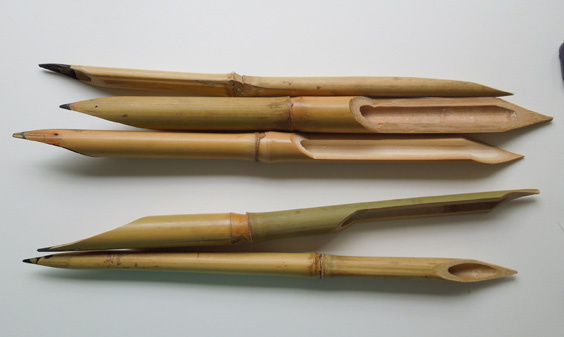FWP:
It's easy to see why the reed-pen might drip blood-- it could have been dipped in the ink of the lover's bloody tears, which are fed from his gouged, ravaged, deeply-wounded heart. But why are the fingers wounded? Wounded fingers are not a big part of the basic ghazal repertoire. Perhaps, as Josh suggests, we're simply meant to assume that the lover has been writing so long that his fingers are raw and bleeding.
But there's also a subliminal connection, I think, through a word that's not even in the verse: the suggestive qalam (see the definition above), with its core relationship to reeds and reed-pens, thus to the cutting and shaping of reeds into reed-pens, thus to writing. To write the heart's pain the lover uses not a reed-pen, but (in some sense) his own fingers. Cut and channeled (like pens) by the sheer force of passion, they not only express by writing, but also directly embody, his suffering. The second line, in short, may offer two descriptions of one thing (his bloody fingers as his pen) that he might show to the beloved, rather than two different things (his bloody fingers, and the pen they have stained). For a very explicit example of this wordplay based on qalam , see {167,6}.
The present verse also poses a question about the efficacy of writing. The question in the first line is obviously rhetorical. But does it imply merely that the speaker is tired of writing, he's been doing it a long time, and now he wants to supplement it by going to her directly and having the consolation of seeing her? Or does it imply that writing-- and even poetry as well-- is entirely futile and useless (that is, that it can't at all express the heart's pain), so that mere telling in written words has to be replaced by the ostensive definition of 'showing'? Is writing of partial and limited use, or--more radically-- of no use at all?
On the use of apnii and apnaa to mean merii apnii and meraa apnaa , see {15,12}.
Compare {118,3}, in which
the lover's whole self is compared to a badly-cut reed-pen.

Nazm:
The pen drips blood first, because of the theme of blood-dripping, and second, because the fingers are wounded. (40)
== Nazm page 40